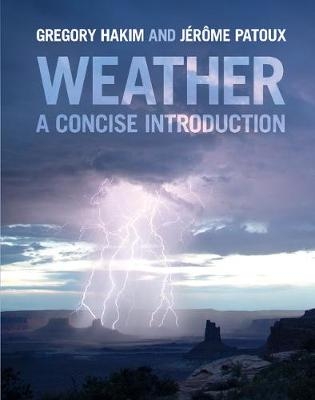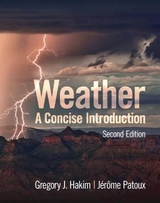
Weather
Cambridge University Press (Verlag)
978-1-108-41716-7 (ISBN)
- Titel erscheint in neuer Auflage
- Artikel merken
From a world-renowned team at the Department of Atmospheric Sciences at the University of Washington, Seattle, Weather: A Concise Introduction is an accessible and beautifully illustrated text covering the foundations of meteorology in a concise, clear, and engaging manner. Designed to provide students with a strong foundation in the physical, dynamical, and chemical processes taking place in the atmosphere, this introductory textbook will appeal to students with a wide range of mathematical and scientific backgrounds. This textbook features: a single case study of a mid-latitude cyclone which is referred to throughout the whole book to illustrate the basic principles driving atmospheric dynamics and phenomena; boxes on more advanced topics; appendices for additional coverage; chapter summaries listing the 'take-home' points discussed; and colour figures and charts illustrating the fundamental concepts. Key terms are evident throughout, and a glossary explains the terms that students will need to understand and become familiar with.
Gregory J. Hakim has undergraduate degrees in Mathematics and Atmospheric Science and a Ph.D. in Atmospheric Science from the State University of New York, Albany. He joined the Department of Atmospheric Sciences at the University of Washington in 1999, where he served as Department Chair from 2012 to 2017 and is currently a Professor. He is also a leading scientist in the areas of weather analysis, predictability, and dynamics, and his research interests include weather and climate prediction, hurricanes, past climates, and polar circulation patterns. He has served on the advisory panel for the Directorate of Geosciences at the National Science Foundation, as Chair of the advisory panel for the Mesoscale and Microscale Meteorology Laboratory at the National Center for Atmospheric Research (NCAR), as a member of the NCAR Advisory Panel, as a member of the NCAR Strategic Planning Council, and as Chair of the University Corporation for Atmospheric Research's President's Advisory Committee on University Relations. Jérôme Patoux earned a Master in Environmental Engineering from the University of Texas, Austin and a Ph.D. in Atmospheric Science from the University of Washington. He has been funded by the National Science Foundation (NSF), the National Aeronautics and Space Administration (NASA), the Office of Naval Research (ONR), and the National Oceanic and Atmospheric Administration (NOAA). He has taught undergraduate introductory meteorology for many years, and has been funded by the NSF to develop weather and climate curriculum. He is a former faculty member from the Department of Atmospheric Sciences at the University of Washington, and currently teaches meteorology at the University of Nantes in France.
Preface; Introduction; 1. Weather variables; 2. Spatial representations of weather data; 3. Our atmosphere: origin, composition, and structure; 4. Heat transfer; 5. Water; 6. Cloud formation; 7. Precipitation; 8. Wind; 9. Global wind systems; 10. Air masses, fronts, and mid-latitude cyclones; 11. Thunderstorms and tornadoes; 12. Hurricanes; 13. Weather forecasting; 14. Air pollution; 15. Climate change and weather; Glossary; Credits; Index.
| Erscheinungsdatum | 16.03.2018 |
|---|---|
| Zusatzinfo | Worked examples or Exercises; 7 Tables, color; 205 Plates, color; 267 Halftones, color; 4 Line drawings, color; 1 Line drawings, black and white |
| Verlagsort | Cambridge |
| Sprache | englisch |
| Maße | 225 x 283 mm |
| Gewicht | 980 g |
| Themenwelt | Naturwissenschaften ► Geowissenschaften ► Meteorologie / Klimatologie |
| ISBN-10 | 1-108-41716-7 / 1108417167 |
| ISBN-13 | 978-1-108-41716-7 / 9781108417167 |
| Zustand | Neuware |
| Haben Sie eine Frage zum Produkt? |
aus dem Bereich



